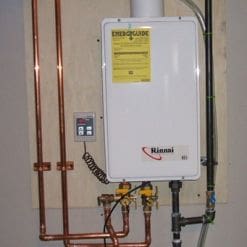
When determining the best water heater [1] for your San Diego home, the recovery rate of hot water heaters is more important than the actual capacity. The total hot water demand for the home should be taken into consideration when determining the appropriate size of the water heater. The water heater location, energy input in BTU’s (British Thermal Units) or kilowatts, and tank capacity in gallons (if purchasing a tank) should all be given consideration.
Tankless Water Heaters vs Tank Water Heaters
How a Tankless Water Heater Works
Once a hot water faucet is turned on, cold water enters the tankless water heater [1]. The burners ignite and the cold water is heated in the heat exchanger. The hot water flows to the faucet or appliance. When the faucet or appliance is turned off, the tankless water heater goes into standby mode. It works on demand by using sensors and a computer board, to detect the demand for hot water in the home and adjust the rate of firing, supplying just the right amount.
How a Storage Hot Water Heater Works
Storage (or tank) hot water heaters have a cylindrical tank that keeps water continually hot and ready for use. They are most commonly powered by electricity, natural gas, propane, heating oil, or solar energy. It’s important to consider insulation for tank models because insulation prevents standby heat loss. There are various high-efficiency models that can be considered.
Which type of water heater is best for my home?
Tankless Water Heaters: Location, Location, Location!
In most cases, a tankless water heater would be best. Due to their smaller size and because they do not pose a flooding threat (as a tank full of water would), there are a lot more location options when installing tankless water heaters. This means that it is easier to add additional hot water heaters should your home’s hot water demand require this. Hence, they can usually be installed closer to the demand site so that there is less lag time between the water heater and the faucet or appliance.
Lifetime of Tankless Water Heaters
Tankless water heaters typically last 15 to 20 years, compared to 10 years or less for a tank-type water heater. This is especially important in San Diego, where we have some of the hardest water in the nation. Hard water means more build-up in your system, and even more so with a tank system. As with any appliance, regular maintenance is recommended.
Tankless Water Heaters Save Money & Energy
The more popular reason that San Diego homeowners tend to prefer tankless heaters is because they save money, water, and energy. Besides saving money on monthly utility bills by using less water and energy, some models can come with big tax incentives and rebates. Just about everyone likes to save money, and San Diegans also enjoy the feeling that they are doing their part as environmentally responsible citizens!
One additional consideration before installing tankless water heaters is the size of the gas line connecting to the heater. Since tankless water heaters heat water instantly, they require a more powerful heating system to heat the water quicker. This means having a larger gas line than most tank-type water heaters and you should consult a San Diego plumbing [2] professional to see if your water heater install requires expanding the gas line.
Contact us [3] today to schedule a water heater flush or to learn more about going tankless.